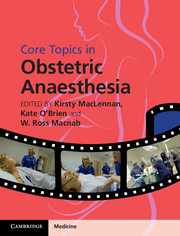Book contents
- Frontmatter
- Contents
- List of contributors
- Preface
- Section 1 Basic science, epidemiology and service organization
- Section 2 Obstetric aspects
- Section 3 Provision of anaesthesia
- 8 Incidental anaesthesia during pregnancy
- 9 Non-regional analgesia techniques for labour
- 10 Regional analgesia techniques for labour
- 11 Regional anaesthesia for operative delivery
- 12 General anaesthesia for caesarean section and transverse abdominal plane block
- 13 Anaesthesia for other obstetric indications: cervical suture, external cephalic version, controlled ARM, manual removal of placenta and perineal repair
- Section 4 Medical conditions in pregnancy
- Section 5 Postpartum complications and obstetric emergencies
- Section 6 Service organization
- Index
- Plate section
- References
13 - Anaesthesia for other obstetric indications: cervical suture, external cephalic version, controlled ARM, manual removal of placenta and perineal repair
from Section 3 - Provision of anaesthesia
Published online by Cambridge University Press: 05 December 2015
- Frontmatter
- Contents
- List of contributors
- Preface
- Section 1 Basic science, epidemiology and service organization
- Section 2 Obstetric aspects
- Section 3 Provision of anaesthesia
- 8 Incidental anaesthesia during pregnancy
- 9 Non-regional analgesia techniques for labour
- 10 Regional analgesia techniques for labour
- 11 Regional anaesthesia for operative delivery
- 12 General anaesthesia for caesarean section and transverse abdominal plane block
- 13 Anaesthesia for other obstetric indications: cervical suture, external cephalic version, controlled ARM, manual removal of placenta and perineal repair
- Section 4 Medical conditions in pregnancy
- Section 5 Postpartum complications and obstetric emergencies
- Section 6 Service organization
- Index
- Plate section
- References
Summary
Cervical cerclage
Introduction
Preterm birth is defined as delivery before the 37th week of pregnancy and accounts for 7.6% of all live births. Prematurity is the leading cause for perinatal death and disability. With improvements in neonatal care, infants that reach 26 weeks’ gestation have a survival rate of approximately 80%; however, up to 50% will have some form of disability, e.g. neurodevelopmental deficits, gastrointestinal and lung disease. The incidence of prematurity is increasing, in the UK from 7% (1995) to 8.6% (2010) and in the USA 9.5% (1981) to 12.8% (2006); this is mainly from an increase in medically indicated preterm delivery e.g. pre-eclampsia and fetal growth restriction. The economic burden as a result of prematurity is immense, in the UK it was £939 million/year (2009) and in the USA $2.9 billion/year (2007).
The causes of spontaneous preterm birth are multifactorial; however, one of the strongest predictors of spontaneous preterm labour is short cervical length.
Cervical insufficiency is characterized by recurrent painless cervical dilation and spontaneous mid-trimester birth; the diagnosis relies on previous clinical history. The Cochrane Collaboration reviewed the evidence for cerclage for preventing preterm birth in a singleton pregnancy in 2012. The nine randomized trials included showed that ‘compared to expectant management the placement of cervical cerclage in women at risk of preterm birth significantly reduces the risk of pre-term births’. However there is a lack of neonatal outcome and follow-up data.
Types of cervical cerclage
History indicated: should be offered to women with three or more previous preterm births and/or second trimester losses. Usually performed at 12–18 weeks gestation.
Ultrasound indicated: women with a history of one or more mid-trimester losses or preterm births who are undergoing ultrasound surveillance should be offered ultrasound-indicated cerclage if the cervix is 25 mm or less and before 24 weeks’ gestation.
Transabdominal cerclage: this can be used following failed vaginal cerclage or extensive cervical surgery. This requires laparotomy or laparoscopy.
Rescue cerclage: the decision to perform rescue cerclage needs to be made by a senior obstetrician; the evidence of improved neonatal outcome in this situation is very limited.
Contraindications to cervical cerclage insertion:
Active preterm labour
Clinical evidence of chorioamnionitis
Continual vaginal bleeding
Preterm prelabour rupture of membranes
Evidence of fetal compromise
Lethal fetal defect
Fetal death.
- Type
- Chapter
- Information
- Core Topics in Obstetric Anaesthesia , pp. 92 - 96Publisher: Cambridge University PressPrint publication year: 2015



